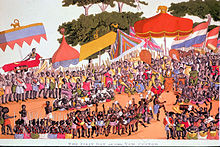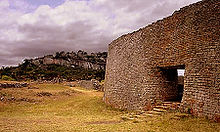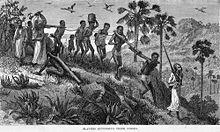- Ninth to eighteenth centuries
African horseman of Baguirmi in full padded armour suit, painting of 1901.
The intricate 9th-century bronzes from Igbo-Ukwu, in Nigeria displayed a level of technical accomplishment that was notably more advanced than European bronze casting of the same period.
Pre-colonial Africa possessed perhaps as many as 10,000 different states and polities characterized by many different sorts of political organization and rule. These included small family groups of hunter-gatherers such as the San people of southern Africa; larger, more structured groups such as the family clan groupings of the Bantu-speaking peoples of central, southern, and eastern Africa; heavily structured clan groups in the Horn of Africa; the large Sahelian kingdoms; and autonomous city-states and kingdoms such as those of the Akan; Edo, Yoruba, and Igbo people in West Africa; and the Swahili coastal trading towns of Southeast Africa.
By the ninth century AD, a string of dynastic states, including the earliest Hausa states, stretched across the sub-Saharan savannah from the western regions to central Sudan. The most powerful of these states were Ghana, Gao, and the Kanem-Bornu Empire. Ghana declined in the eleventh century, but was succeeded by the Mali Empire which consolidated much of western Sudan in the thirteenth century. Kanem accepted Islam in the eleventh century.
In the forested regions of the West African coast, independent kingdoms grew with little influence from the Muslim north. The Kingdom of Nri was established around the ninth century and was one of the first. It is also one of the oldest kingdoms in present-day Nigeria and was ruled by the Eze Nri. The Nri kingdom is famous for its elaborate bronzes, found at the town of Igbo-Ukwu. The bronzes have been dated from as far back as the ninth century.[76]

- Ashanti yam ceremony, nineteenth century by Thomas Edward Bowdich
The Kingdom of Ife, historically the first of these Yoruba city-states or kingdoms, established government under a priestly oba (‘king’ or ‘ruler’ in the Yoruba language), called the Ooni of Ife. Ife was noted as a major religious and cultural centre in West Africa, and for its unique naturalistic tradition of bronze sculpture. The Ife model of government was adapted at the Oyo Empire, where its obas or kings, called the Alaafins of Oyo, once controlled a large number of other Yoruba and non-Yoruba city-states and kingdoms; the Fon Kingdom of Dahomey was one of the non-Yoruba domains under Oyo control.
The Almoravids were a Berber dynasty from the Sahara that spread over a wide area of northwestern Africa and the Iberian peninsula during the eleventh century.[77] The Banu Hilal and Banu Ma’qil were a collection of Arab Bedouin tribes from the Arabian Peninsula who migrated westwards via Egypt between the eleventh and thirteenth centuries. Their migration resulted in the fusion of the Arabs and Berbers, where the locals were Arabized,[78] and Arab culture absorbed elements of the local culture, under the unifying framework of Islam.[79]

- Ruins of Great Zimbabwe (flourished eleventh to fifteenth centuries)
Following the breakup of Mali, a local leader named Sonni Ali (1464–1492) founded the Songhai Empire in the region of middle Niger and the western Sudan and took control of the trans-Saharan trade. Sonni Ali seized Timbuktu in 1468 and Jenne in 1473, building his regime on trade revenues and the cooperation of Muslim merchants.
His successor Askia Mohammad I (1493–1528) made Islam the official religion, built mosques, and brought to Gao Muslim scholars, including al-Maghili (d.1504), the founder of an important tradition of Sudanic African Muslim scholarship.[80] By the eleventh century, some Hausa states – such as Kano, jigawa, Katsina, and Gobir – had developed into walled towns engaging in trade, servicing caravans, and the manufacture of goods. Until the fifteenth century, these small states were on the periphery of the major Sudanic empires of the era, paying tribute to Songhai to the west and Kanem-Borno to the east.

- 1803 Cedid Atlas, showing a map of the African continent from the perspective of the Ottoman Empire. The Ottomans controlled much of Northern Africa between the 14th and 19th centuries, and had vassal arrangements with a number of Saharan states.
Mansa Musa ruled the Mali Empire in the 14th century.
Height of the slave trade
See also: Arab slave trade and Atlantic slave trade

- Arab–Swahili slave traders and their captives along the Ruvuma River (in today’s Tanzania and Mozambique) as witnessed by David Livingstone
Slavery had long been practiced in Africa.[81][82] Between the 7th and 20th centuries, the Arab slave trade (also known as “slavery in the east”) took 18 million slaves from Africa via trans-Saharan and Indian Ocean routes. Between the 15th and the 19th centuries, the Atlantic slave trade took an estimated 7–12 million slaves to the New World.[83][84][85] In addition, more than 1 million Europeans were captured by Barbary pirates and sold as slaves in North Africa between the 16th and 19th centuries.[86]
In West Africa, the decline of the Atlantic slave trade in the 1820s caused dramatic economic shifts in local politics. The gradual decline of slave-trading, prompted by a lack of demand for slaves in the New World, increasing anti-slavery legislation in Europe and America, and the British Royal Navy’s increasing presence off the West African coast, obliged African states to adopt new economies. Between 1808 and 1860, the British West Africa Squadron seized approximately 1,600 slave ships and freed 150,000 Africans who were aboard.

- Slave being inspected, from Captain Canot; or, Twenty Years of an African Slaver
Action was also taken against African leaders who refused to agree to British treaties to outlaw the trade, for example against “the usurping King of Lagos“, deposed in 1851. Anti-slavery treaties were signed with over 50 African rulers. The largest powers of West Africa (the Asante Confederacy, the Kingdom of Dahomey, and the Oyo Empire) adopted different ways of adapting to the shift. Asante and Dahomey concentrated on the development of “legitimate commerce” in the form of palm oil, cocoa, timber and gold, forming the bedrock of West Africa’s modern export trade. The Oyo Empire, unable to adapt, collapsed into civil wars.


